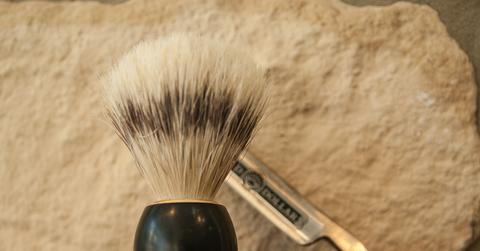The Age Of The Sustainable Shave Is Back And Better Than Ever
Most adults shave. But the garbage we produce by doing so is staggering. The Environmental Protection Agency (EPA) estimates that Americans toss 2 billion disposable razors every year, but traditional blades offer the sustainability we need.
Updated May 22 2019, 4:07 p.m. ET
Look at any action humans undertake on a regular basis, and you may find something that could be greener than it is. Shaving is no exception. Almost all adults shave, including 58 percent of women and 75 percent of men. And the garbage associated with this practice is staggering: The Environmental Protection Agency (EPA) estimates that Americans toss 2 billion disposable razors annually.
Similarly to how we look to World War II victory gardens as marks of where we might go in producing our own food, the past holds many answers to our future. And how we used to shave our bodies may hold to key to reducing waste during this basic, frequent activity.
Back in the day, things were built to last.
Old-school razors were made to last a lifetime—quite a novelty in today’s throwaway culture. That’s probably why they haven’t changed a bit in their design since gaining popularity several centuries ago. It may also be why they’re coming back so fiercely as a trend among millennials.
Chrome-finished razors run in the $30 range and are designed to last you decades. Blade replacements cost roughly $10 for a pack of 100. Start doing this math, and you’ll learn quickly that those disposable razors might not actually be cheaper after lifetime use.
If you want to go even greener, get your hands on a straight-edge razor. The traditional blades never need replacement—you just sharpen them up and keep them clean, and you’ll never spend more than the initial $100 upfront cost.
Ironically, when the Earth seemed limitless we reused and built the most.
“Planned obsolescence” was an actual concept crafted in the 1920s and 1930s as manufacturing was on the rise. The idea was simple: Constantly offer consumers upgrades and slight variations on products so they’d toss the old and buy the new.
It’s ironic to think that when the world seemed its most expansive that we reused the most. Now, when we know about finite resources, we’re surrounded by an economy propped up by planned obsolescence. Not until Gillette started marketing disposable razors as timesaving devices in the early 1900s did people even begin to think this concept made any sense at all.
The environmental cost of packaging ought to be disposed of.
The packaging for lifetime razors is often recyclable (or compostable!) cardboard and wax paper. Can’t say that about the plastic packaging around disposables—or the body of the razors themselves. Single-use razors don’t last more than a few weeks with regular use, and those with sensitive skin or seeking closer shaves usually don’t use them more than once or twice. That cheap price tag adds up significantly over your lifetime.
Reusable razors with replacement heads are slightly less wasteful, but not by much. Those heads are not recyclable and more costly, and come in excessive packaging. You can also look into recycled, disposable razors like those offered by Preserve. But it’s important for the greenies among us to remember that recycled doesn’t mean eco-friendly when you’re still dealing with packaging that gets thrown out. The key to sustainability is using less altogether.
Shaving cream could be more eco-friendly, too.
What we use to lather up before shaving also takes a toll on the environment and our health. Shaving creams often come in disposable packaging with contents that are loaded with perfumes, dyes, and harmful chemicals. Handmade shaving creams are easy to make and will save you a bundle. If you don’t have time to DIY, seek out soap lathers that come as limited-ingredient bars and have minimal packaging.
The moral of story? Aim to do it right the first time.
The key to green living and saving money over time is to do things properly out of the gate. When we think we’re getting a deal, we’re usually paying for it later. When it comes to your personal grooming habits, paying the upfront cost for a razor that will last you years will be better for your skin, better for the environment, and better for your wallet.
